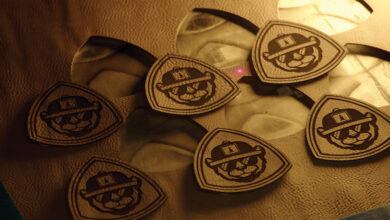Although these terms are often used interchangeably, there are differences between laser marking, laser etching, and laser engraving. Each type of process has its own applications and attributes that make it ideal for different jobs.
Laser marking is what happens when the beam interacts with the surface of a material, slightly altering its properties or appearance. It is achieved by moving a low-powered beam slowly across the material, by a method called discoloration, which creates high-contrast marks without disrupting the material. The laser heats the material, causing oxidation under the surface, and turning the material black. There are four common types of laser marking: annealing, carbon migration, foaming, and coloration. All of this is done while leaving the surface intact.
Laser engraving is a process where the laser beam physically removes the surface of the material. This creates a cavity in the surface that is noticeable to the eye and touch. The laser creates high heat, which essentially causes the material to vaporize. It’s a quick process, as the material is vaporized with each pulse. It can be repeated with several passes to form deeper engraving.
Although engraving is a subsection of laser marking, it differs in many ways.
- There are three types of laser engraving: etching, deep laser engraving, and laser ablation (the difference between the three is what the surface is and how much you remove).
- This is the most common form of lasering used by decorators.
- Maximum engraving depth is 0.020 of an inch on metals, but can go as deep as 0.125 of an inch in materials such as graphite.
- This is the fastest way to mark with a laser.
- It’s ideal for parts expected to experience high wear.
- You can engrave on almost any kind of metal, plastic, wood, leather, or glass surface.
Laser etching, which is a subset of laser engraving, occurs when the heat from the beam causes the surface of the material to melt. The laser beam uses high heat to melt the surface of the material, and the melted material expands and causes a raised mark. Unlike with engraving, the depth in etching is typically no more than 0.001 of an inch.
-Aaron Grimes, TYKMA Electrox



